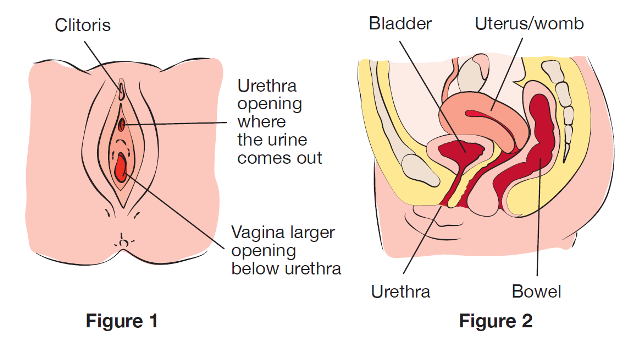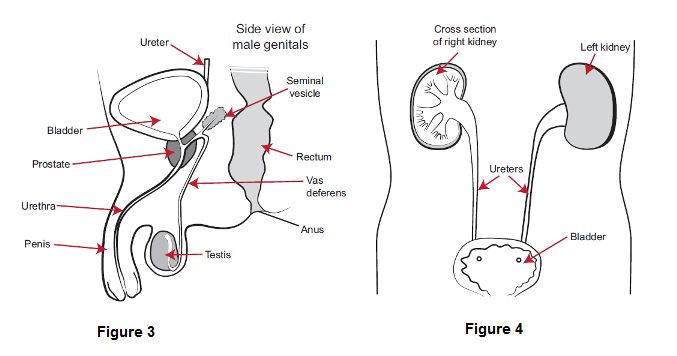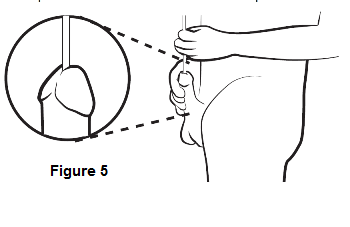Your self-intermittent catheter
This procedure involves you passing a plastic tube, called a catheter, down the urethra (the channel you normally urinate down) and into the bladder (see figure 1, 2, 3 and 4).
Intermittent self-catheritisation allows urine to drain freely and the bladder to be emptied, after which the tube is removed.
Female
Figure 1 – The urethral and vaginal openings on a female.
Figure 2 – Cross section of female abdomen.

Male
Figure 3 – Cross-section of male penis and abdomen.
Figure 4 – Location of bladder and kidneys in males.

Your doctor may have recommended this procedure for a number of reasons.
How will I know when to catheterise myself?
Initially you will catheterise on a timed basis, for example every 4 to 6 hours.
The most important thing is that you do not allow your bladder to fill over 500 mls.
You will then either continue timing your catheters or adjust it depending on your fluid intake.
For example if you have had 500 mls to drink then it’s time for a catheter.
Gradually you will become better and quicker at this.
If you feel the urge to urinate, and the volume you feel this at is always below 500 mls, then you can use your catheter on urge.
Will I get wet between catheters?
Initially while your routine is established you may leak.
If this happens your doctor will identify the cause and try to fix it.
This may be through:
- using medication to calm the bladder
- exercises
- surgery.
You must discuss this with your doctor.
The aim is to keep you dry between catheters.
You may also leak if you get a urine infection.
In this case you will need to see your GP for treatment.
Advantages of self-intermittent catheterisation
- It mimics the normal bladder function of filling and emptying.
- There is no permanent catheter left in the bladder.
- It has a lower risk of infection and other complications than other management options.
Disadvantages of self-intermittent catheterisation
- You need to manage your fluid intake including fluids such as alcohol and caffeine which increase the amount of urine you produce.
- You will need a certain degree of hand function to perform self-intermittent catheterisation.
- Initially self-intermittent catheterisation can be time consuming, but this will improve as you become better at it.
Do I need follow up visits with my doctor?
You will need to visit your doctor at least once a year to:
- monitor for complications and treat them early if required
- ensure you are doing well.
It is your responsibility to ensure your yearly appointments are maintained.
Performing catheterisation
Your nurse will teach you how to do your catheterisation before you are discharged home from hospital and will explain to you how often you need to do your catheter.
You will need the following items for preparing your catheter:
- catheter
- water based lubricating gel
- measuring container if required
- clean flannel, soap and water or moist towelettes.
When you are ready to use your catheter
Both males and females should:
- try to pass urine naturally (if appropriate)
- wash and dry your hands
- collect your equipment and place it in a clean, dry area that is easy to reach.
Males
- Adjust clothing so that you can get to your penis easily.
- Using soap and water or moistened towelettes wash and dry the area.
- If you are not circumcised you will need to pull back your foreskin and wash yourself.
- Wash and dry your hands thoroughly.
- Place the unopened catheter packet, clear side facing downwards, on a flat surface.
- Peel back from the coloured end of the catheter for 5 cms. Gently grasp hold of the funnel to stabilise the catheter and prevent it from flicking out of the packet.
- Slowly peel back the paper side of the packet and remove completely without touching the catheter. The catheter should remain in the clear packet.
- Drop lubricant onto the tip of the catheter and for about 5 cms along the tube.
- Without touching the catheter (that is, grasp hold of it through the packet) pick it up and hold it like a pen in your dominant hand and peel back the clear packet to reveal the tip of the catheter.
- With your other (non-dominant) hand grasp hold of your penis and hold it at an angle (see figure 5).

- Gently but firmly push the catheter into the penis 5 cms. Hold the shaft of the penis firmly so that the catheter does not fall out and peel back the paper to expose another 5 cms of catheter to be inserted. Continue to insert the catheter in this way.
- You may encounter some resistance at the point where the catheter reaches the prostate gland and the closed sphincter muscle. If it is stuck do not force the catheter but try coughing, bearing down (as though you want to pass urine) or deep breathing whilst keeping gentle pressure against the resistance. You will then feel the catheter give and it can be pushed into the bladder.
- You can now remove the paper completely and wait for the urine flow.
- Return the penis to its natural position and hold onto the catheter until the flow of urine stops.
- Make sure you direct the flow of urine into the toilet or container.
- When the flow has stopped, have a cough and press gently over your bladder as more urine may flow out by doing this.
- Slowly pull out the catheter and place it in a bowl or dispose of it in the bin.
- Replace your foreskin.
- Wash and dry yourself and then wash and dry your hands.
Females
- Adjust your clothing. Get into a comfortable position.
- Using soap and water or moistened towelettes wash and dry the area.
- Wash and dry your hands thoroughly.
- Place the unopened catheter packet, clear side facing downwards, on a flat surface.
- Peel back from the coloured end of the catheter for 5 cms. Gently grasp hold of the funnel to stabilise the catheter and prevent it from flicking out of the packet.
- Slowly peel back the paper side of the packet and remove completely without touching the catheter. The catheter should remain in the clear packet.
- Drop lubricant onto the tip of the catheter and for about 5 cms along the tube.
- Without touching the catheter (that is, grasp hold of it through the packet) pick it up and hold it like a pen in your dominant hand and peel back the clear packet to reveal the tip of the catheter.
- With your non-dominant hand, gently part the labia (or lips of your vagina) to expose the urethra (the channel you normally urinate through).
- Gently insert the catheter into the urethra and continue to gently push it in until you drain urine.
- If it is stuck do not force the catheter. Remove the catheter and try again later.
- Hold on to the catheter until the flow of urine stops.
- Make sure you direct the flow of urine into the toilet or container.
- When the flow has stopped, have a cough and press gently over your bladder as more urine may flow out by doing this.
- Slowly pull out the catheter and place it in a bowl or dispose of it in the bin.
- Wash and dry yourself and then wash and dry your hands.
Where to get help
Remember
- Clean intermittent self-catheterisation allows urine to drain freely and the bladder to be emptied.
- The most important thing is that you do not allow your bladder to fill over 500 ml.
- Initially while your routine is established you may leak.
Acknowledgements
Royal Perth Hospital
This publication is provided for education and information purposes only. It is not a substitute for professional medical care. Information about a therapy, service, product or treatment does not imply endorsement and is not intended to replace advice from your healthcare professional. Readers should note that over time currency and completeness of the information may change. All users should seek advice from a qualified healthcare professional for a diagnosis and answers to their medical questions.